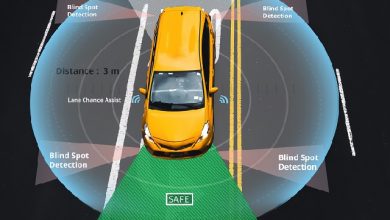Emerging Automotive Technologies and Products
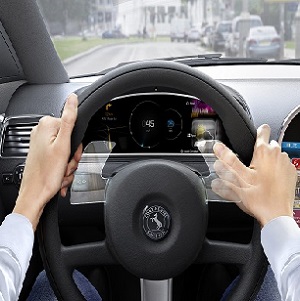
Today Automotive original equipment manufacturers (OEMs) and suppliers face a complex environment, unlike anything the industry has experienced before. Innovations is multidirectional and individually each segment or part of a vehicle is undergoing an innovational transformation. Who could have imagined ‘tyre’ or ‘steering wheel’ to become smart and play active role in assisting drivers. To master these changes and successfully operate in new places with new partners, automakers need to rapidly adjust their core. They need to be able to work with new innovative partners in transforming ecosystems while remaining open to absorbing new technologies and capabilities. Automotive sector has over the last few years has emerged as the converging point for emerging technologies, existing products and services. Artificial intelligence and Machine Learning is impacting automakers, vehicle owners, and service providers. Number of companies are using AI/ML for managing the voluminous data being generating through connected vehicle to get meaningful insights into elements which can be monetised. Infotainment panel has started moving into the space which has been dominated by mobile phone for over a decade and half. Making calls, tracking business meeting and appointment schedules, digital payment and entertainment through music is available on the infotainment panel. The public and goods transport will go through paradigm shift with autonomy taking over, in the next decade+ time frame.

In recent months, a growing number of carmakers such as BMW, Ford, General Motors and Daimler, are joining forces with tech startups or bought stakes in companies to press ahead with innovations.
The technologies which will hasten the transition of automotive are many and fast-changing. These are elements that will impact the autonomous vehicle, connected vehicle, ADAS(advanced driver assistance system), and vehicle telematics. Some of the emerging technologies which we think would change the automobile in coming decade are:
Electric Vehicle Battery
The electric vehicle is going to be the way forward for the automotive and battery will play a key role here. Cost and durability have been two factors that have been talked about in the recent past. Going by the developments, we feel three factors are going to be noteworthy:
- Longevity– recent million mile battery- Contemporary Amperex Technology Co. Ltd. (CATL) has developed electric vehicle battery which can last about 16 years and 2 million kilometres (1.24 million miles), according to a Robin Zeng, CEO, CATL.
- Solid-State Battery– These batteries use solid electrodes and a solid electrolyte, instead of the liquid or polymer gel electrolytes found in lithium-ion or lithium polymer batteries. There is more power per given weight in these batteries. They are smaller and hence reduce the physical size of device using the battery. They can stay in the field longer and can store harvested energy. Presently Toyota, Dyson, NGK, Solid Power, LG Chem, Samsung SDI, SK Innovation and some of the leading car makers are working on solid-state battery which is expected to hit market by 2025.
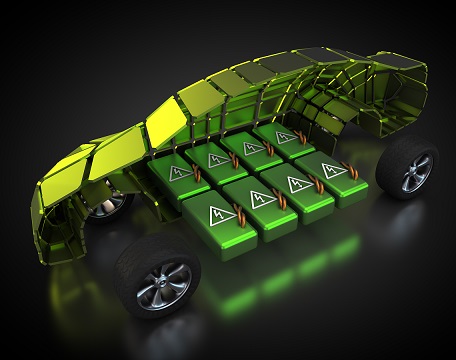
Battery infused body panel / Energy Storing Body Panels
In 2013, EU funded project STORAGE, which had Imperial College, London and Volvo Cars teamed up for an experimental project, which replaced the hood, door panels and trunk lid, with rechargeable carbon fiber panels. Each of the carbon fiber composite panels were infused with flexible super-capacitors capable of harnessing the energy generated through regenerative braking, and discharge back into the electric motor when needed. The composite material also reduced the weight by 60% compared to existing components. While the technical outcome was encouraging, commercialisation will be subject to the cost of carbon fibre, including recycled carbon fibre also which is too expensive, compared to steel or aluminium.
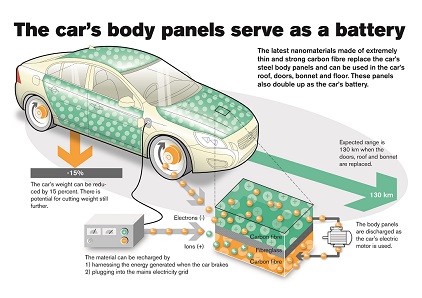
Smart Tyres
In 2017, Goodyear showcased its demonstrative tyre, Eagle 360 Urban. The tyres’ outer surface is made of elastic polymer(bionic skin), giving it the flexibility much alike human skin, allowing it to expand and contract as per the road surface condition. In case of puncture, the sensor in the tread can locate it and the tyre rotates to change the contact patch. This reduces pressure on the puncture and allows the self-healing process to start. The self-healing works thanks to materials which are specifically designed to be able to flow towards the puncture. They react physically and chemically with each other to form new molecular bonds, closing the puncture.
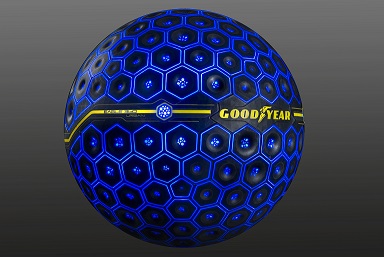
Solid State Lidar
LiDAR are important sensors, playing a critical role in ADAS and autonomous vehicles. Traditionally the LiDAR has been an electromechanical device with motor rotating the light pulse emitter. In contrast, solid-state LiDAR does not require any moving parts. It is built on a silicon chip and is resilient to vibrations. More importantly, it costs lesser than electromechanical LiDAR. Leddartech, Robosense, Quanergy, Xenomatix, Texas Instrument, Draper, Aeva, and many others are in some stage of solid LiDAR development.
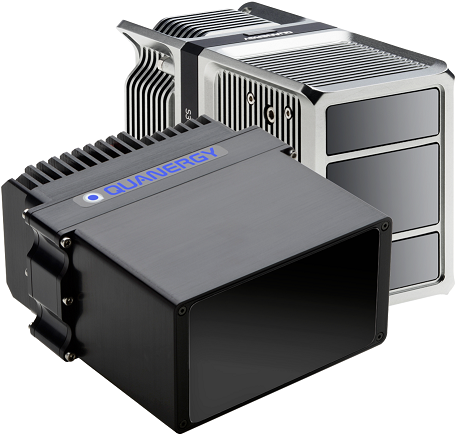
Artificial Intelligence & Machine Learning
The transition of automotive into future mobility which will be autonomous and connected, will be powered by AI/ML. There is a phenomenal amount of data which is being generated by sensors & ECUs in automobiles, vehicles in a connected ecosystem, etc. To get any meaningful insight into these data lakes, companies are using AI/ML which is helping them with improved vehicle maintenance, street map updation through crowdsourced data, traffic data and prediction etc. AI/ML is also a key driver behind vehicle autonomy. Argo, Otonomo, Waymo are names that represent different spectrums of the automotive industry using AI/ML.

Inflatable Solar Panel Car Cover
A Ford patent application was filed on November 8, 2019, has been published on May 14, 2020, for a roof-mounted device that, with a flip of a switch, covers the entire parked vehicle in a shield of solar panels. It’s been more than six years since Ford introduced its C-Max Solar Energi Concept. In 2014, at CES, Ford showed the rooftop solar system that tracks the sun’s movement and uses a Fresnel lens to concentrate its energy to charge the C-Max plug-in hybrid. The company claimed the system could produce 8 kilowatts of power.
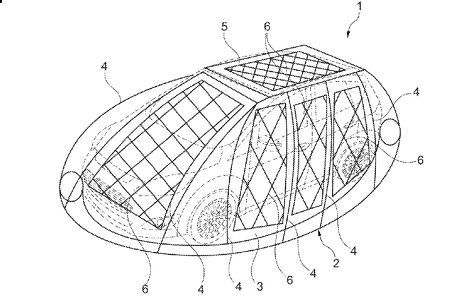
Big Data & Analytics
Big Data Analytics has the potential to deliver a competitive advantage to the automotive industry by creating new revenue generation opportunities. Nowadays, companies build abilities to leverage big data analytics by quickly generating new insights based on an analysis of structured and unstructured data. Companies are using these insights to design new and innovative products and services that are driven by data to fulfill the business priorities and customer needs. Volvo has adopted data analytics to glean valuable insights through its data sets derived through vibrations, temperature, and pressure sensors in their cars.
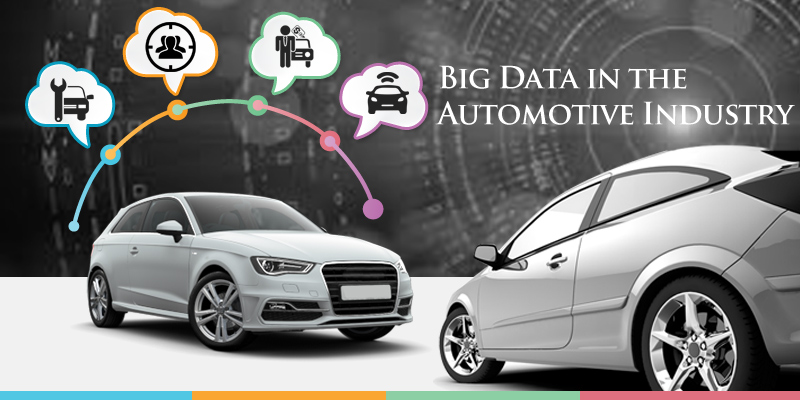
The Business model of BMW relies on big data for its core processes starting from design, engineering, support, production, sales along customer assistance. They use some of the most innovative technologies such as AI, predictive data analytics, that focus on building the future cars which can be driven without any human intervention on the roads.
Volkswagen has produced cars by combining predictive analytics into its sales activities. By using behavioral analytics and prediction analysis, Volkswagen is able to provide their dealerships with increased opportunities for boosting their sales and improving customer retention.With the use of proprietary technologies, thousands of data points are captured through the dealer management systems which are combined with big data comprising of social media profiles, product, consumer lifecycle, financial records, etc. This helps in arriving at the ‘Behavior Prediction Score’ which is a ranking that helps in revealing the number of customers that are likely to buy to the dealers.
Tesla has been banking on data gathering and data analysis way before its competitors. All Tesla vehicles send data to the cloud. In 2014, through this data gathering, monitoring, and analysis, Tesla was able to detect the problem of overheating of certain engine components and it was able to “automatically repaid” every vehicle using a software patch.
Quantum Computing
While still in an early stage of development quantum computers are already making an impact in the automotive sector, including electric vehicles.
Volkswagen demonstrated use of quantum computing to improve efficiency of traffic routing. In collaboration with Google and D-wave, VW plans to implement quantum computing to reduce traffic congestion. Traffic data is captured with help from smartphones and transmitters inside vehicles. This data is processed in a non-quantum algorithm to decide the traffic density in a given area as well as the number of customers requiring a carrier. This outcome can then be easily processed by a quantum algorithm to optimize the number of carriers available versus the number of customers requiring a carrier. Optimization can be done by directing cabs or a public transport service carrier appropriately towards the focus area.
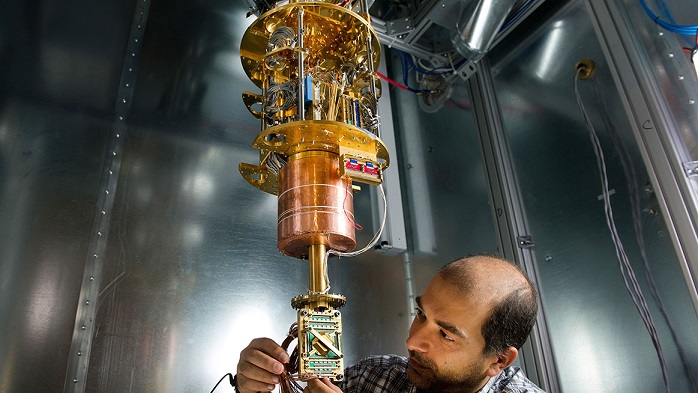
(Image Source: Volkswagen)
IBM, Daimler researchers use quantum computer to simulate Li-sulfur battery chemistry. Daimler has joined hands with Google to research the application of quantum computing to mobility. ISARA Corporation, the technology facilitator of crypto-agile security and quantum-safe has ensured that the demonstration car of Karma Revero GT which was showcased at CES 2020 can send and receive electronic voice data without any hesitation that the information will be hijacked or gathered – even by a quantum-enabled adversary.
Blockchain
The vehicle of the future is expected to be connected, autonomous, shared and electric. Automotive sector started harnessing the power of blockchain in the mid of last decade. Many automakers like Toyota, BMW, Ford, Porsche, Renault, Mercedes-Benz, and so on have started leveraging blockchain technology in areas such as supply chain, security, car service, manufacturing process, insurance, ride-sharing, ownership transfer, EV charging, autonomous vehicles, and more. OEMs are also making significant investments in technology startups for the development of blockchain-based solutions.
Two years back Mobility Open Blockchain Initiative (MOBI) consortium was launched in partnership with leading stakeholders from across the entire automotive value chain in May 2018.
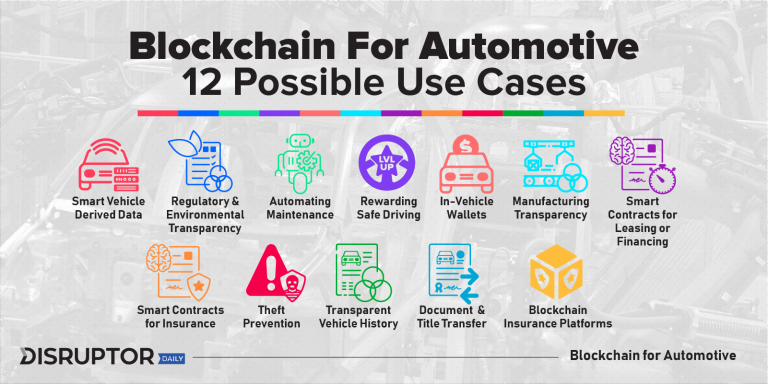
In February 2018,Porsche paired with blockchain startup, XAIN, to implement blockchain technology in their vehicles and won the first Porsche Innovation Contest on the subject of blockchain.
In April 2019, BMW Group outlined the new blockchain-based VerifyCar app built with VeChain, which was part of the BMW Startup Garage. In 2019, BMW Group also started the PartChain project to ensure seamless traceability of components using Blockchain.
In February 2017, Daimler AG joined Hyperledger. Hyperledger is a collaborative cross-industry effort which was created to advance blockchain technology. On June 28, 2017, Daimler also announced their first blockchain-based transaction with the major commercial banking company, Landesbank Baden-Württemberg (LBBW).
The Mobility Blockchain Platform at Daimler Mobility AG is aimed at sustainably optimizing booking and invoicing processes for mobility solutions.
In March 2020, Toyota Motor Corporation and Toyota Financial Services Corporation launched Toyota Blockchain Lab.
IOTA and Volkswagen presented their Proof-of-Concept (PoC) for IOTA’s new tangle technology at the CEBIT 2018 Expo in Germany. Tangle is a blockchain developed by IOTA that allows for updates to be applied to various technological devices in near real time. Volkswagen aimed at utilising IOTA’s tangle system to update their autonomous vehicles and provide information about the Volkswagen car to drivers. In April 2019, Volkswagen announced a partnership with blockchain company Minespider with a vision to improve battery supply chain with blockchain technology. From mine to factory, Volkswagen claims to make the supply chain transparent with blockchain.
In February 2019, Mercedes-Benz developed a prototype program which allows a transparent mapping and understanding of this transmission across the entire supply chain. The company announced its partnership with Icertis.
In January 2020, Mercedes-Benz Cars has set itself a high goal of launching a carbon neutral new passenger car fleet in less than 20 years with its pilot project,”Ambition2039″. It requires detailed knowledge of all climate relevant processes associated with the entire vehicle value chain. In order to achieve this, Mercedes-Benz is creating transparency of CO₂ emissions and the use of secondary material in the supply chain. In relation to this as part of STARTUP AUTOBAHN, Mercedes-Benz has also started a pilot project with a key battery cell manufacturer and Circulor, a start-up in blockchain technology.
Groupe Renault has been using blockchain technology since 2015 and considers the blockchain as a vector for the transformation of the automotive industry. The company claims that some twenty projects to deploy this technology have been identified. Their focus is traceability of financial transactions and communication with equipment manufacturers and the sales network which will hopefully be deployed very soon.
In July 2017, Groupe Renault announced a prototype for a digital car maintenance book leveraging blockchain technology. Renault partnered with Blockchain leaders like Microsoft and VISEO to store its car’s passport information in a secure and transparent manner on the blockchain-based data storage system.
Human- Machine Interface
Nowadays the vehicles are inclined towards smartphone-centric infotainment systems which have boosted the popularity of multimodal in-car interfaces.
Today, vehicles are connecting with software products and services, and the design of HMI is becoming increasingly driver-focused with features like UX/UI solutions that shorten driver response time, improved interaction between human-vehicle, and deliver better user experience supplemented with mobile features which is already in use by the drivers. Some of the HMI trends are- Screens/Display, Voice Commands, Haptic Touch, Drive by Wire, Virtual Assistants, Taking Control, Being Connected
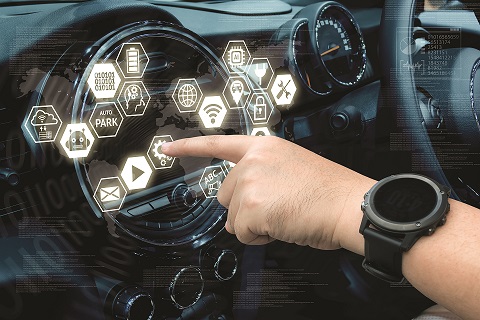
HMI solutions which are becoming commonly available are:
- Heads Up Display (HUD) is one of the most popular HMI solutions. In HUD, the information is displayed directly in front of the driver onto the windshield.
- Rear Seat Smart Entertainment system – Connect your phone and operate directly from the touch screen, watch movies and listen to music through the multimedia inputs.
- Voice recognition and voice guidance – Providing cloud-based voice recognition services
- Integrated web & mobile navigation – Building applications that integrate web and mobile navigation systems
- UX/UI design & usability research
- Realistic & high-performance 3D rendering
3D gesture technology
Automotive manufacturers are offering a plethora of infotainment and other electronic features to enhance the user experience. However, it is known that controlling multiple devices and functionality features will distract drivers. This is where 3D gesture technology comes into picture as it will allow users to control many elements of their vehicle with mere gestures. The vision is to prevent the driver from visual distraction to ensure that our future roads are safer than ever.
Automotive gesture recognition comprises electronic systems installed in automobiles as a part of the human-machine interface (HMI).
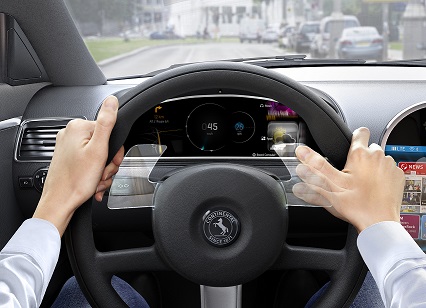
In July 2018, Microchip Technology released the MGC3140, a 3D gesture recognition controller that claimed to offer the lowest system cost for advanced automotive HMI designs. The single-chip solution is AEC-Q100-qualified capacitive technology-based air gesture controller that provides reliable sensing in full sunlight and with sensors of any conductive material.
In February 2019, BYTON announced its partnership with PMD Technologies AG with an aim to use their 3D Time-of-Flight (ToF) sensors for the in-car gesture control camera system operating the Shared Experience Display in BYTON’s first production model, the M-Byte SUV. The pmd 3D ToF sensor has a set of illuminators at the top of M-Byte’s Camera that emits invisible light into the car cockpit. The sensor measures the time it takes for the camera light to bounce back from objects and person enabling the in-car gesture control camera system.In May 2016, Continental announced that it has integrated gesture-based control into the area of the center console and steering wheel, enabling drivers to control functions with just a swipe of their hand or motion of their fingers. These systems use near-infrared (NIR) light in the 850-940 nm range, applying structured light and time of flight (TOF) methods to convert the hand positions and gestures of the driver detected by the sensor into actions.
In May 2017, SoftKinetic®, 3D vision and gesture recognition solutions provider announced that its 3D Time of Flight (ToF) vision technologies would be included in the 2017 BMW 5 Series cars. The company also powered infotainment gesture control in the BMW 7 Series luxury line.
Sony unveiled its All-Electric Vision-S Concept Car at CES 2020 and announced that it was also making investments into LIDAR and Time of Flight (ToF) camera technologies to provide an optimized infotainment system that features gesture control.
Micromobility
Micromobility is emerging as an alternative travel solution for short distances which involves lightweight, low-speed vehicles that can be shared or privately-owned, and are pushed, pedaled or electrically powered. It offers innovative and quick solutions to resolve issues such as parking and traffic congestion. Many cities are creating cycle lanes and car-free zones to help ease overcrowding on shared and public transport for encouraging the use of private micro-mobility vehicles.

Some of the pilot projects in this direction are-
Micro mobility model in Munich was experimented in 2019 to provide a perspective on how mobility in the city could develop via three different scenarios. The experiment of e-scooter cruising in Munich’s street for 100 days with six e-scooter companies- Bird, Circ, Hive, Lime, Tier, and Voi; supporting the initiative, and installed more than 2,000 shared e-scooters within the first 100 days. It was a successful experiment that reduced time of travelers with jam-free journeys, proving to be a medium to fill the first- and last-mile gaps in public-transport.
Companies like Citi Bike and Jump Bikes in the US and Ofo and Mobike in China are providing suitable options to the consumers for last-mile transportation.
Conclusion
Modern smart vehicles will be more like connected computers on wheel that will generate huge amounts of data. Companies have started combining the cutting-edge emerging technologies in the automotive functions which will speed up the pace of innovation drastically to make the car a “Classy Drawing Room or Meeting Room on Wheels.” For making this a reality, automakers need to build strategic cross-industry partnerships with technology companies to bring ‘software-defined’ vehicles and keep ahead of the competition.
Authors:
Anuj Sinha
Deputy CEO
Telematics Wire
Yashi Mittal
Manager-Corporate Communication
Telematics Wire
Published in Telematics Wire



